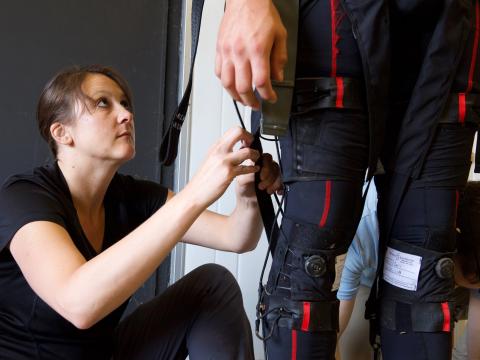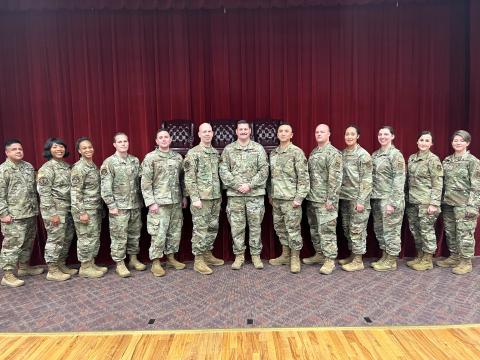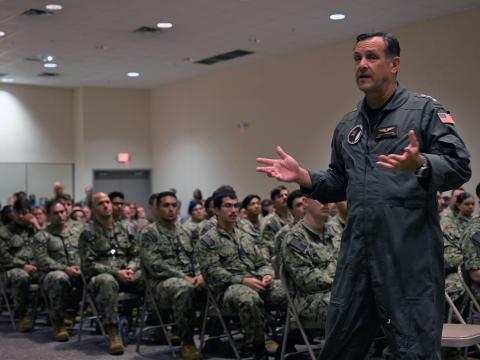Sniffing Out Danger
Scientists at the U.S. Army Research Laboratory, Adelphi, Maryland, are working with researchers in academia and industry to miniaturize capabilities such as chemical identification to make them small enough to fit on a dime-size computer chip. The work is being conducted with the University of Michigan and University of Pennsylvania through the Cooperative Technology Alliance contract vehicle.
Military laboratory collaborates with academia to develop minisensors that detect chemical molecules. 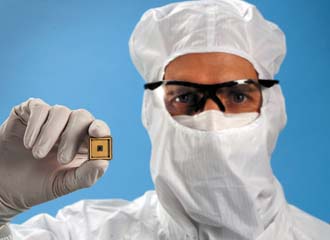
Autonomous robots soon could be equipped with electronic noses that perceive the chemical signatures of explosives, chemical and biological weapons, and even humans. A portable micro gas chromatograph system is being designed to fit on a dime-size chip so it can be incorporated into unmanned systems without adding significant weight or increasing space or energy requirements. Work is underway on several fronts, including perfecting the sensor itself and experimenting with it on robotic platforms that could be in the field later this decade.
The research is part of a collaborative effort between scientists at the U.S. Army Research Laboratory (ARL), Adelphi, Maryland, and two universities. Because it is complex, the creation of an autonomous robot that can identify danger or rescue trapped humans involves expertise in numerous areas, including weapons, materials, sensors, electronics and robotics. Ultimately, technology resulting from this research could become part of a squad of minirobots that collaborate to maneuver and discover dangers, then report back to controllers located a safe distance away.
In addition, because the technology is so small, it could be integrated into warfighters’ uniforms or manned vehicles, creating a portable network of chemical and biological systems. Architectures such as these could act as early warning systems that support homeland defense by adding them into transportation infrastructures, including subways, commercial airlines and buses.
Dr. William D. Nothwang is a material scientist who is the government lead, micro autonomous systems and technology, Microelectronics Center, ARL. He explains that the current work on the minisensor system is part of a larger contracting vehicle called the Cooperative Technology Alliance. Numerous ARL directorates are involved in the alliance and, as part of alliance agreements, personnel from industry or academia are matched with government scientists within a program to delve into government research projects. The University of Michigan, University of Pennsylvania, University of Maryland and BAE Systems lead the four centers that comprise other organizations that participate in alliance projects.
Two research teams, one at the University of Michigan and one at the University of Pennsylvania, are involved in the mini gas chromatograph project. The robotics aspect of the effort also includes research from other organizations. Scientists collaborate via teleconferencing as well as site visits to each other’s facilities. University researchers also collaborate independently of the ARL. All told, approximately two dozen personnel from the ARL and universities are working on the micro gas chromatograph project.
Dr. Brian Sadler, electrical engineer, Computational and Information Sciences Directorate, ARL, leads the research on the robotic side of the project. He relates that currently, the bulk of the work is taking place on the sensors, with some experimentation occurring in the robotic platform area. The experimentation aims at determining potential environments for using the sensors, as well as the processing requirements for deriving a “control all” capability for the robots.
A gas chromatograph detects and identifies chemical molecules based their individuality. Each chemical has a unique signature, and each travels at different speeds while in vapor form. For the separation part of the process, molecules are processed using tubes in which small molecules move faster than large molecules. The detector focuses on specific portions of a molecule to find the chemicals of interest. Collecting a concentrated amount of a chemical improves the chances that the identification of the chemical will be correct.
Nothwang relates that the minisensor will act as an electronic nose to detect common scents and sort chemicals just as current gas chromatographs do now; the difference is that today’s devices are “generally the size of a dishwasher,” he notes. “Every chemical in the environment will have something that will go into the vapor phase. So exactly like an electronic nose, the sensor will sniff this material and will tell you what general class and sometimes what specific chemical you have.”
Research conducted over the past several years has decreased the size of the tubes in the gas chromatograph process. As a result, the overall dimensions of the device can be reduced to the size of a quarter and perhaps to the size of a dime, he adds.
“By going to that really small size, you not only save a huge amount of weight but also a huge amount of the power [it requires]. Power for these sensors are their Achilles’ heel,” Nothwang relates. “The savings in the power is phenomenal.”
The three green layers on the printed circuit board (t) make up the micro gas chromatograph that scientists at the University of Michigan designed and fabricated. For experiments, it was mounted on a Scarab robot (b) that University of Pennsylvania researchers designed and fabricated.
The recent ARL effort focuses on the Orion, a second-generation system based on the Mercury gas chromatograph that University of Michigan scientists developed while working with the National Science Foundation Wireless Integrated Microsystems Engineering Research Center from 2000 to 2010. Mercury provides the selectivity, sensitivity and rate analysis at a small size and weight with reduced power needs, which enables tactical deployment, Nothwang says. The laboratory now is contributing its expertise to the university to create Orion, the even smaller sensor that can fulfill Army-relevant applications. 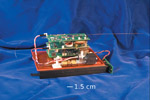
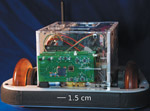
“Gas sensing systems with this degree of sensitivity and specificity have typically been large, stationary monitoring devices. The chemical bouquet that the soldier is exposed to is exceptionally crowded, and many of these chemical scents are potentially dangerous, toxic or hazardous. Having the ability to detect these chemicals in very minute concentrations amid a crowded background enables a new level of sensory awareness,” Nothwang states.
From Sadler’s perspective, small sensors pose some interesting possibilities because they inspire work in other areas such as his team’s research into small, networked computers. As part of the Cooperative Technology Alliance agreement for the minisniffers, researchers simultaneously have been designing robots that are smaller than existing platforms—small enough to fit in the palm of a hand. “And we’re working on technology that is even smaller,” he offers. These new e-creatures could take the form of helicopters and platforms that flap wings or crawl, he says.
The sensor-laden robots are apt to be sent into very complex environments. This will require a platform to perceive its environment, navigate around it and somehow communicate with the user. “But ultimately, I don’t want to have to tele-operate it; I’d rather it drove itself to some degree of autonomy,” Sadler says.
But equipping minirobots with electronic noses is just the first step along an exciting, never-ending road. As a result of past research, current small robots can rove about a building and map its rooms and dimensions. In the future, these same robots equipped with minisensors also would be able to create a map of the presence and concentration of chemicals throughout a building or a natural structure such as a cave. Initially, these robots would collect the information, exit the building and deliver their findings to the user. As communications capabilities improve, several sensor-laden robots would not only communicate with each other to the point of collaboration within the coverage area but also send their findings to users located away from the danger zone, Nothwang relates.
Sadler adds that because the robots are small, soldiers easily could carry several of them. The vision is that soldiers would release several e-creatures around a building, that would work collectively to gather information and report it back to the soldier. “That’s the kind of application we’re working toward,” he states.
In 2010, the collaborative team began prototyping an integration of the Mercury gas chromatograph with the Scarab, a fully autonomous robot that the University of Pennsylvania designed and developed as a research tool to investigate robotic autonomous behavior. Scarab is approximately the size of iRobot Corporation’s Roomba, a self-directing vacuum cleaner. For the experiment, the University of Michigan team integrated the Mercury onto the platform, and scientists from the University of Pennsylvania created a series of autonomous behaviors to enable it to enter a room, search for explosives, identify chemical agent characteristics and communicate back the exact location and nature of the agent.
Nothwang points out that these final steps will take considerable research as well as advances in communications because capabilities such as the Global Positioning System do not function well, if at all, inside buildings. In his opinion, reaching the stage of collaborative minirobots being able to sweep a building still may be four to five years away. That said, if a commercial company would take up the basic research, invest in additional work and build sensors that could be fielded, progress might proceed more quickly, he adds.
Sadler, although cautious, is a bit more optimistic about how soon these capabilities could be in the hands of warfighters. He admits that producing sensors and robots that are rugged enough to go into the field is always a challenge, but once that hurdle has been overcome, getting the equipment into the field can be accomplished on platforms the size of today’s PackBots in a matter of weeks.
“The larger research question is, ‘Will this platform be fully tele-operated or can I add to more sophisticated behaviors?’ Also, with regard to flying, we don’t really have that much in the field in the way of small flying things. So the kind of small flyers that we are conducting experiments with are more toy-like than Army-like.
“In addition, we need to do enough research to characterize the false alarm rates so that when we put these in a soldier’s hand, he or she trusts it enough to be able to rely on information,” Sadler notes. Achieving a stage of deployment at this level will require reviewing and settling on field-use doctrine, tactics, techniques and procedures, which must take place before the capabilities are ready for prime time, he adds.
WEB RESOURCES
Army Research Laboratory: www.arl.army.mil
iRobot Corporation: www.irobot.com
University of Michigan: http://research.umich.edu
University of Pennsylvania: www.upenn.edu/researchdir
